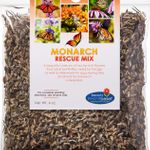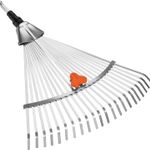We’re back in East Berlin, Pennsylvania (Zone 6b) visiting with Barb Mrgich today. We’ve visited her flower-filled garden before, but yesterday we got a different kind of tour of the butterflies that visit her garden and the plants they need to thrive. Today is the second part of the tour.
I came upon this beautifully marked black swallowtail one day while working in my garden. It had obviously emerged recently from its chrysalis and was waiting for its wings to dry before it could fly. I don’t know the significance of the colorful markings on the underside of its wings, but it sure was a beauty!
I was thrilled to come upon this unusual guy in my garden one day. I looked him up and found that he is a giant swallowtail. Giant he was! The article says he hosts on citrus and is actually considered a pest in the Florida citrus groves. He is a long way from home! He liked the zinnias and hung around all day. Then he left, and I’ve never seen another one. (Editor’s note: In cold climates where citrus doesn’t grow, giant swallowtail caterpillars can feed on other plants, including rue [
Ruta graveolens, Zones 4–8] and prickly ash [
Zanthoxylum americanum, Zones 3–7].)
Here are two common buckeyes. They have no connection to the Ohio buckeye tree. They are so named because of the large eye spot on their wings. Among other plants, buckeyes host on snapdragons. They are said to especially like nectaring on purple coneflowers (Echinacea purpurea,
Zones 3–8). Buckeyes fly south in the winter, usually to Florida.
The first time I ever saw a red admiral, I got very excited because I really didn’t know any butterflies then. I Googled “dark butterfly with red stripe down wing,” and it came right up. Here he is on sedum (Hylotelephium spectabile,
Zones 3–9). Butterflies tend to like flowers with a wide landing zone, and sedum certainly provides that! This butterfly’s favorite host plant is stinging nettle, a vicious plant I don’t want anywhere near my garden. I have only ever encountered stinging nettle in Florida, and brushing against it was worse than a bee sting! Surprisingly to me, the red admiral is rather prevalent in my Pennsylvania yard. Like the painted lady, he packs it up and flies to warmer climates in the winter months.
Here is a butterfly that can fool a lot of people. It looks almost exactly like a monarch, but it is a resident butterfly for me. This is a viceroy butterfly. This viceroy is also nectaring on sedum. For me, the distinguishing mark to tell it from a monarch is the thin black line that runs across his hindwing. I call it his necklace. This butterfly hosts on native willows like pussy willow (Salix discolor,
Zones 3–8) and actually winters over in its caterpillar form! The immature caterpillar rolls itself up in a leaf of its host plant as winter nears, then drops to the ground with the leaf. There it stays until spring, when it crawls back up the tree and begins to eat.


Agapanthus
. Agapanthus,
sometimes called lily of the Nile, is prevalent in warmer states, and most plants are not hardy in Pennsylvania. Although I consider myself a wildlife and native plant gardener, I just had to have one. I was delighted the day I found one of these plants in a small, backyard nursery for sale. It has grown here for years and has created a rather noticeable patch. The flowers are smaller than the ones I have seen in California, and the blooms don’t last as long, but they do attract pollinators!
I was at a friend’s house one day, and she was showing me her Tithonia
plants, which she had grown from seed. As we were admiring the flowers, a monarch fluttered in to nectar. As I snapped the camera, a hummingbird photo-bombed the picture!
One very popular nectar plant I haven’t yet mentioned is the Brazilian verbena (Verbena bonariensis,
Zones 7–10 or as an annual). An annual in my climate, it will reseed itself prolifically all over your garden. It is one of those “see through” plants that can mingle with just about any other plants and be beautiful wherever it goes. Butterflies absolutely love it. Here it is serving its nectar to a painted lady butterfly. Painted ladies host on a good many weeds, such as thistle and nettle. They also use rose mallow, which is also known as hardy hibiscus (Hibiscus moscheutos
and related hybrids, Zones 5–8). I see quite a few of them in my gardens.
I love to take photos in my garden. This one has always been one of my favorites: an eastern swallowtail on liatris.
Have a garden you’d like to share?
Have photos to share? We’d love to see your garden, a particular collection of plants you love, or a wonderful garden you had the chance to visit!
To submit, send 5-10 photos to [email protected] along with some information about the plants in the pictures and where you took the photos. We’d love to hear where you are located, how long you’ve been gardening, successes you are proud of, failures you learned from, hopes for the future, favorite plants, or funny stories from your garden.
Have a mobile phone? Tag your photos on Facebook, Instagram or Twitter with #FineGardening!
Do you receive the GPOD by email yet? Sign up here.
Fine Gardening Recommended Products
National Wildlife Federation®: Attracting Birds, Butterflies, and Other Backyard Wildlife, Expanded Second Edition (Creative Homeowner) 17 Projects & Step-by-Step Instructions to Give Back to Nature
Fine Gardening receives a commission for items purchased through links on this site, including Amazon Associates and other affiliate advertising programs.
From the National Wildlife Federation, the largest U.S. nonprofit conservation organization, with 6 million members and 51 state and territorial affiliated organizations. 17 step-by-step projects that everyone can do together make getting your family back to nature easy, educational, and fun. Over 200 color photos of backyard wildlife habitats and the wide variety of creatures they attract, plus step-by-step photos and illustrations for family projects. Learn wildlife-friendly practices for gardening, landscape design, supplemental feeders, birdbaths, nesting places, and more. Learn how to attract backyard pollinators, from bees and butterflies to beetles, bats, and hummingbirds
Get your garden certified by the National Wildlife Federation's Garden for Wildlife(TM) program by following the included certification application checklist.
Monarch Butterfly Rescue Wildflower Seeds 4 oz.
Fine Gardening receives a commission for items purchased through links on this site, including Amazon Associates and other affiliate advertising programs.
HIGH QUALITY SEEDS and EXPERT GUIDANCE: Experience the quality seed difference. We are committed to providing the highest quality, open-pollinated, non-GMO/non-GE seeds to our customers, guaranteed. A trusted source of high quality seeds since 1985. ATTRACT MORE MONARCHS: We know seeds and we know pollinators! Our expertly crafted botanical garden seed mixes contain a wide variety of both perennials and annuals that are specifically designed to attract pollinators. Attract more Monarchs and Butterflies in general. Gardener tested, pollinator approved! All Of Our Wildflower Varieties Are 100% Pure Seed, They come with complete planting instructions. Compare and see the quality value. This Wildflower Seed Mix will make the perfect gift for those gardeners in your life.
Gardena 3103 Combisystem 12-Inch To 20-Inch Adjustable Metal Fan Rake Head
Fine Gardening receives a commission for items purchased through links on this site, including Amazon Associates and other affiliate advertising programs.
With adjustable tine spacing: suitable for raking coarse and fine material. Flexible, zinc-plated spring-steel prongs. Working width adjustable from 12-20 inches. Sold as head only, handle sold separately.
































Comments
Great pics.
Wonderful collection of photos. You are so fortunate to have such a wide variety of butterflies.
Best photo bomb ever!!!!!
Oh wow another great and informative post. Your photography is excellent and you share a wealth of great garden info. Thanks to you I'm thinking of planting some hardy Agapanthus! and because of your post before this- I'm inspired to plant some parsley!
Log in or create an account to post a comment.
Sign up Log in